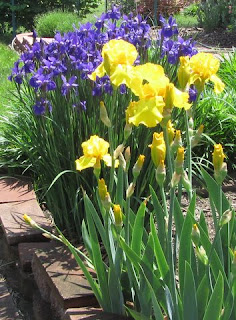 |
| Wall O' Water and Better Boy tomato plant |
You’ve seen the ads in gardening magazines, seed catalogs, and online—ads for plant protectors called Wall O’ Water, which claim they can speed up tomato growth and fruiting by several weeks.
I’ve read those ads for years: Fill the protector with water. Sun warms water which warms soil. Add small plant 6 to 8 weeks earlier that you normally would. Harvest longer. Easy to use. Reusable, three to five years. Great for tomato, squash, pepper, pea, and other veggie plants down to 16° F.
Actually I have two three-packs of Wall O’ Water protectors in our garage—packages I’ve bought over the years but never used. Why? I don’t really know. I actually took them off the shelf and planned to use them this year—but didn’t.
When I was walking through Westside Community Gardens of Columbia Gardeners, Inc., I saw a gardener planting tomatoes. Behind him were taller tomato plants growing in Walls O’ Water.
“Do they work?” I asked Stan Purwin, who’s gardened at Westside for eight of his 35 gardening years.
“Yes,” he replied, inviting me into his fenced plot of raised beds. “I have two Better Boy tomato plants that I planted side by side on May 9. They were the same size. I put a Wall O’ Water around one and not the other. After less than three weeks, the one with Wall O’ Water is several inches taller now than the unprotected one.”
 |
| Stan Purwin and his two Better Boy tomato plants |
“I notice your Walls O’ Water don’t have any water in them,” I said.
“The water wasn’t turned on yet here at Westside Garden Plots when I transplanted in early May, and actually the Walls O’ Water aren’t easy to fill with water, so I just circle the plants with the empty protectors. If I filled the protectors with water, I’m sure my plants would be even taller, by another inch or two.”
Walls O’ Water—maybe in this case we should call them Walls O’ Waterless—work for Stan’s tomatoes. I’m convinced that they work too, now that I’ve seen his Better Boys side by side.
Stan said he buys some of his tomato plants and starts some from seed too. This year, in addition to Better Boy, he’s raising these varieties: Pruden's Purple, Big Mama, Green Zebra, Early Girl, Box Car Willie, Brandywine, San Marzano, Porterhouse, Sweet 100, Whopper, Sugary, Defiant, Wickline, Roma, Aunt Ruby Green, Juliet, Mountain Magic, Celebrity, Big Beef, Rutgers, Aunt Ginny Red Beefsteak, Red Plum, Sugary, Valencia, Sungold, and Virginia Sweets.
Whoa, 27 varieties?
“Yes,” Stan affirmed, “about 54 plants.”
I must have just stumbled into Tomato Heaven—or maybe Tomato Haven.
Why so many?
“I tend to get carried away, and I usually try to plant at least two of each variety in case one fails.”
What does Stan do with all the fruit?
“We eat some. I give some to neighbors and friends and other gardeners here at Westside if their plants haven’t been successful. I give the rest to Grassroots, a nearby local crisis intervention center for individuals and families.”
 |
| Will Stan's Green Zebra tomatoes be ripe on July 4? |
I’ll be picking my first tomatoes two or three weeks after that. Really, next spring I must start some of my tomatoes a month earlier than I usually do and set them out in late April or early May in Walls O’ Water.
And I’ve got to get back to Westside around the Fourth to see what Stan’s picking—real-life tomatoes, many of which I’ve only salivated over as I looked at their photos in seed catalogs.













































